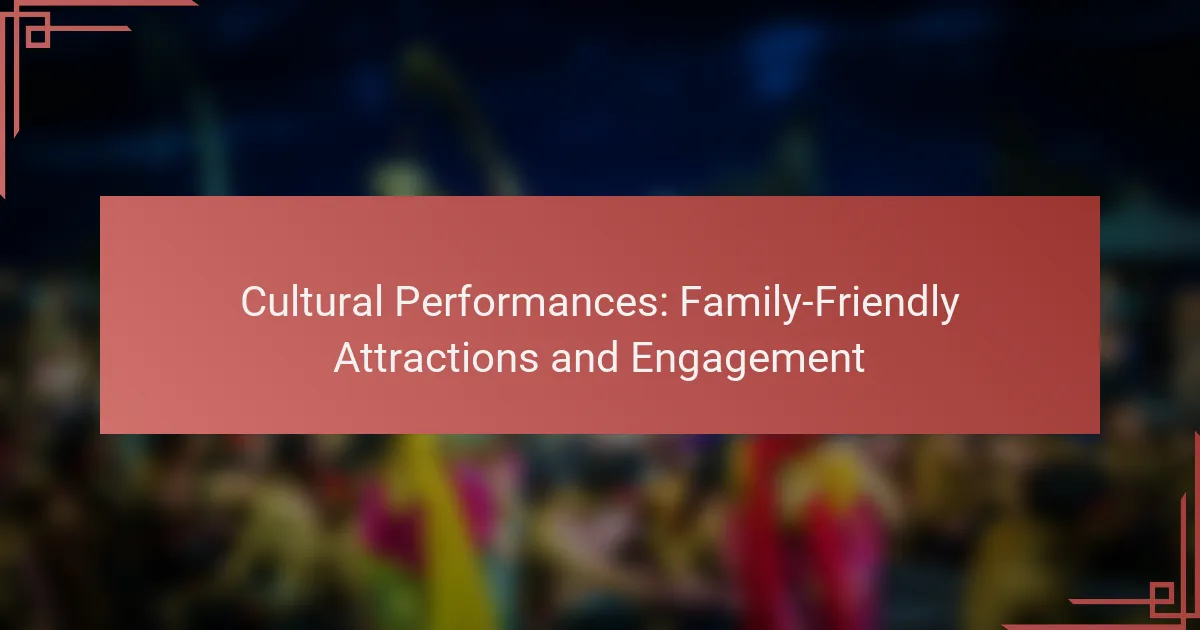Cultural performances are essential for preserving heritage and showcasing the rich diversity of communities in the United States. By engaging audiences and fostering a sense of belonging, these events not only celebrate traditional art forms but also attract visitors, enhancing local economies and cultural landscapes.
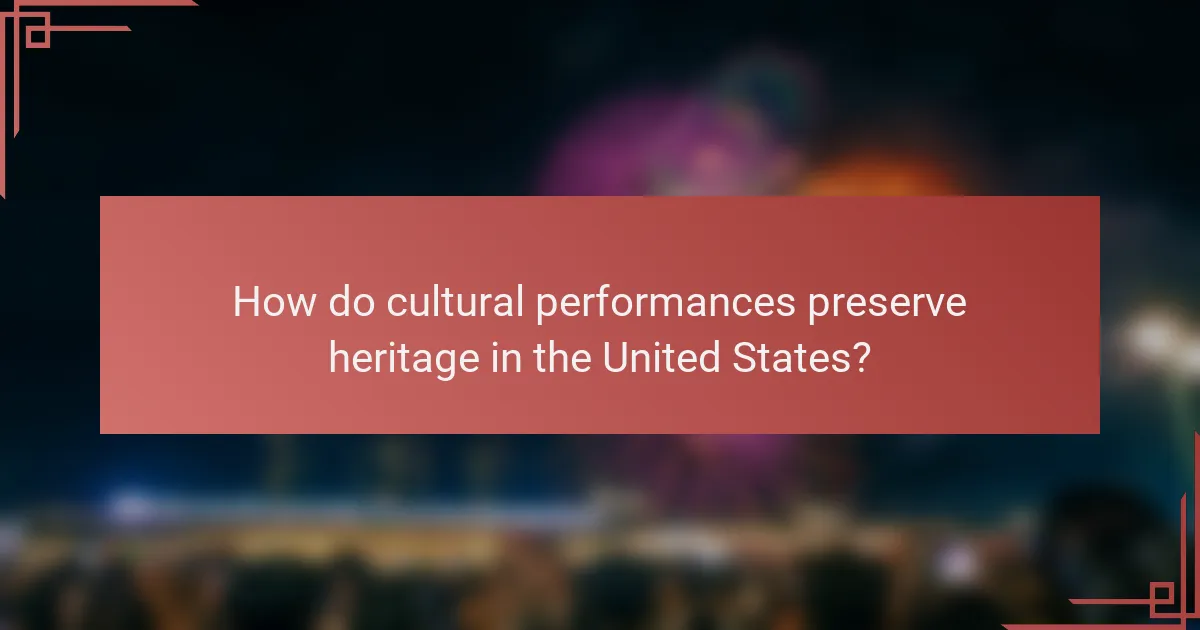
How do cultural performances preserve heritage in the United States?
Cultural performances play a vital role in preserving heritage in the United States by showcasing traditional art forms that reflect the diverse histories and identities of communities. These performances not only celebrate cultural practices but also engage audiences, fostering a deeper understanding and appreciation of heritage.
Traditional music festivals
Traditional music festivals serve as a platform for artists to perform genres rooted in specific cultural backgrounds, such as bluegrass, jazz, or Native American music. These events often feature local musicians and can attract thousands of visitors, creating a vibrant atmosphere that highlights the importance of musical heritage.
To maximize the impact of a music festival, organizers should focus on community involvement, ensuring that local artists are featured prominently. Additionally, offering workshops or interactive sessions can enhance visitor engagement and education about the cultural significance of the music.
Dance showcases
Dance showcases bring together various styles, from folk dances to contemporary interpretations, allowing performers to express their cultural narratives through movement. These events often include both professional and amateur dancers, providing a platform for emerging talent while preserving traditional techniques.
When organizing a dance showcase, consider incorporating educational components, such as pre-show talks or post-performance discussions, to deepen audience understanding of the cultural contexts behind the dances. This approach not only entertains but also educates attendees about the heritage being represented.
Storytelling events
Storytelling events are a powerful way to convey cultural heritage through oral traditions, allowing individuals to share personal narratives and historical tales. These gatherings often feature a mix of professional storytellers and community members, creating an inclusive environment that values diverse voices.
To enhance storytelling events, focus on creating a welcoming atmosphere where participants feel comfortable sharing their stories. Incorporating themes or specific cultural elements can also help guide the narrative, making the event more cohesive and engaging for the audience.
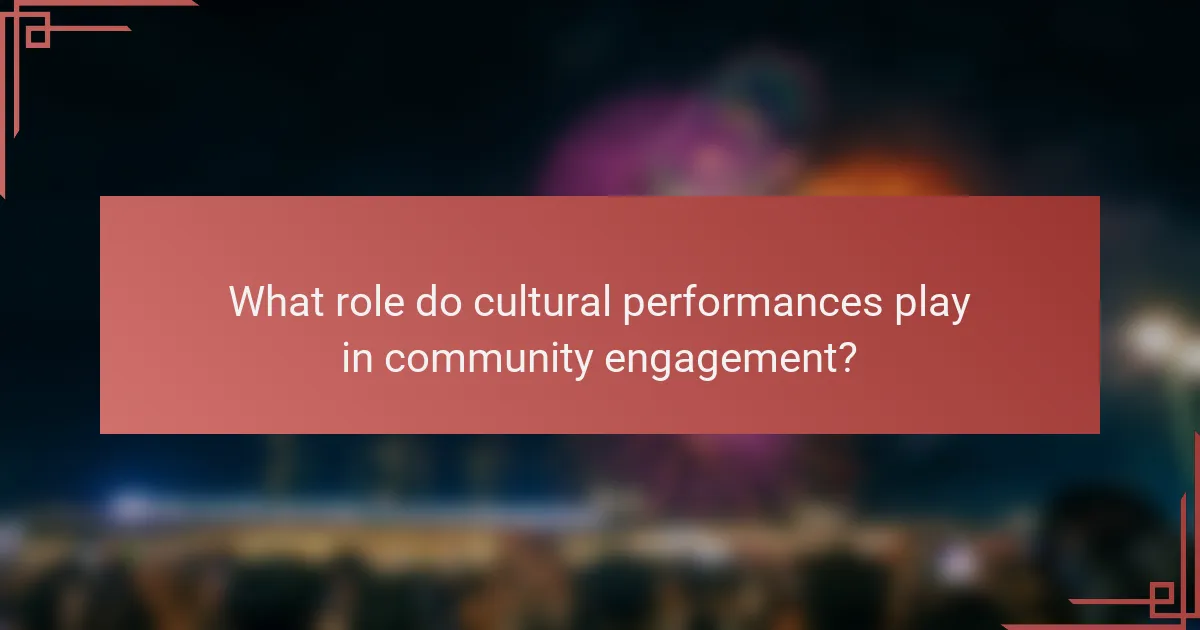
What role do cultural performances play in community engagement?
Cultural performances serve as a vital tool for community engagement by bringing people together through shared experiences and traditions. They foster a sense of belonging and pride, allowing individuals to connect with their heritage and each other.
Building local identity
Cultural performances are instrumental in shaping and reinforcing local identity. They showcase unique traditions, languages, and art forms that reflect the community’s history and values. For example, festivals featuring traditional dances or music can highlight regional characteristics, helping residents and visitors alike appreciate the local culture.
Engaging in these performances allows community members to express their identity and pass on cultural knowledge to younger generations. This transmission of heritage is crucial in maintaining a vibrant local culture.
Fostering social cohesion
Cultural performances play a significant role in fostering social cohesion by bringing diverse groups together. Events such as community theater, music festivals, or dance competitions encourage collaboration among residents from various backgrounds, promoting understanding and unity.
These shared experiences can break down social barriers and create lasting relationships. For instance, a multicultural festival can highlight different cultural expressions, allowing attendees to appreciate and celebrate diversity within the community.
Encouraging volunteerism
Participating in cultural performances often encourages volunteerism within the community. Individuals may contribute their time and skills to organize events, perform, or assist with logistics, fostering a spirit of collaboration and commitment.
Volunteering for cultural events can also enhance personal connections and community pride. People who engage in these activities often find a deeper sense of belonging, which can lead to increased participation in other community initiatives.
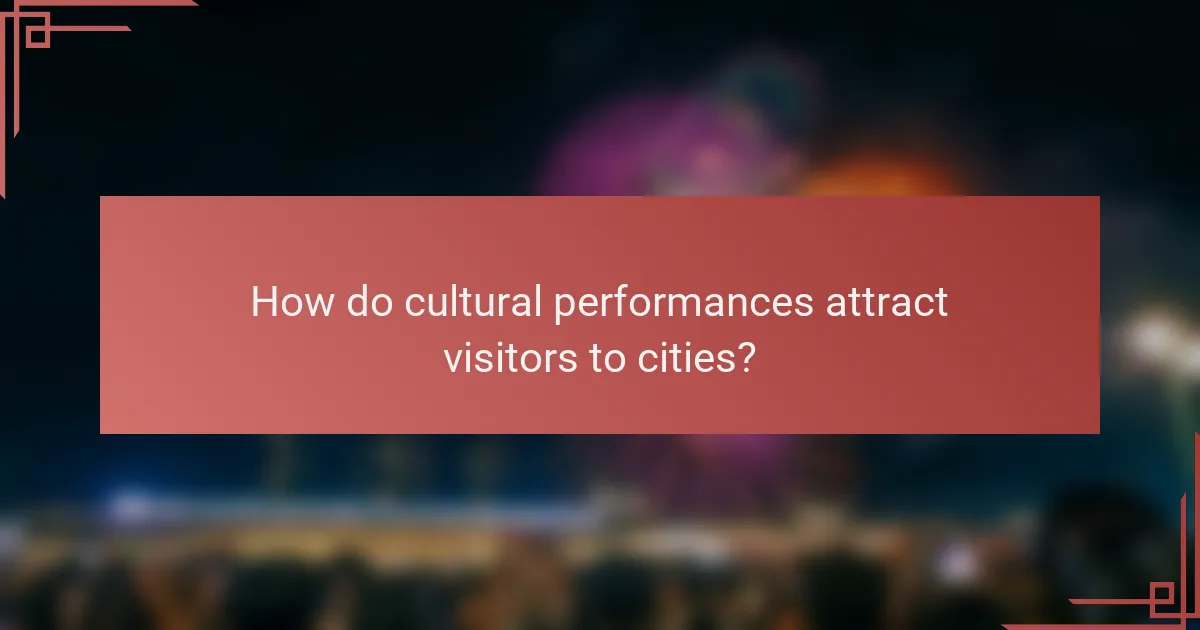
How do cultural performances attract visitors to cities?
Cultural performances draw visitors to cities by showcasing local traditions, arts, and heritage, creating unique experiences that entice tourists. These events not only enhance the cultural landscape but also contribute significantly to the local economy and community engagement.
Tourism revenue generation
Cultural performances serve as a powerful driver of tourism revenue by attracting both domestic and international visitors. Events such as festivals, concerts, and theater productions can increase foot traffic, leading to higher spending in local accommodations, restaurants, and attractions.
For example, a city hosting a renowned music festival may see visitor numbers surge, resulting in millions of dollars in additional revenue over a weekend. This influx can support local businesses and create seasonal job opportunities.
Promotion of local businesses
By attracting visitors, cultural performances provide a platform for local businesses to thrive. Vendors, artisans, and service providers often benefit from increased visibility and sales during these events, fostering a sense of community and collaboration.
For instance, a craft fair held alongside a cultural event can showcase local artisans, allowing them to sell their products directly to a larger audience. This not only boosts individual businesses but also enhances the overall local economy.
Enhancing city reputation
Cultural performances can significantly enhance a city’s reputation as a vibrant and attractive destination. By hosting diverse events, cities can position themselves as cultural hubs, appealing to tourists seeking unique experiences.
Moreover, positive media coverage and word-of-mouth from attendees can elevate a city’s profile, attracting future visitors and potential investors. A city known for its rich cultural offerings is more likely to be included in travel guides and itineraries, further boosting tourism.
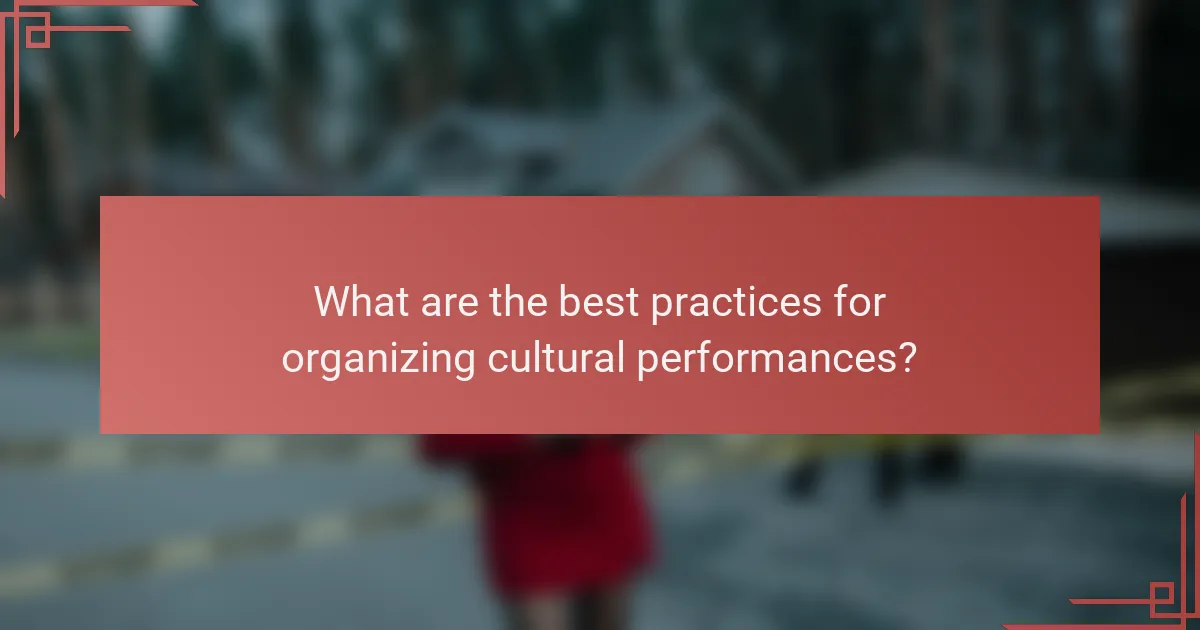
What are the best practices for organizing cultural performances?
Effective organization of cultural performances involves strategic planning, community engagement, and targeted marketing. These practices ensure that events are not only successful but also resonate with audiences and preserve cultural heritage.
Community involvement strategies
Engaging the community is crucial for the success of cultural performances. Involve local artists, schools, and cultural groups in the planning and execution stages to foster a sense of ownership and pride. This can include workshops, open calls for participation, and volunteer opportunities.
Consider hosting community meetings to gather input and ideas. This approach not only enhances the event’s relevance but also builds a supportive audience base that feels connected to the performance.
Effective marketing techniques
Utilizing a mix of traditional and digital marketing strategies can significantly boost attendance at cultural performances. Leverage social media platforms to create buzz, share behind-the-scenes content, and engage with potential attendees. Email newsletters can also be effective for reaching out to local communities.
Collaborate with local influencers or cultural ambassadors to broaden your reach. Offering early bird tickets or group discounts can incentivize attendance and create a sense of urgency.
Partnerships with local organizations
Forming partnerships with local organizations can enhance the impact of cultural performances. Collaborate with schools, community centers, and cultural institutions to access resources, venues, and audiences. These partnerships can also provide financial support or sponsorship opportunities.
Consider co-hosting events with local festivals or cultural fairs to increase visibility. Such collaborations can lead to shared marketing efforts and a larger audience, benefiting all parties involved.
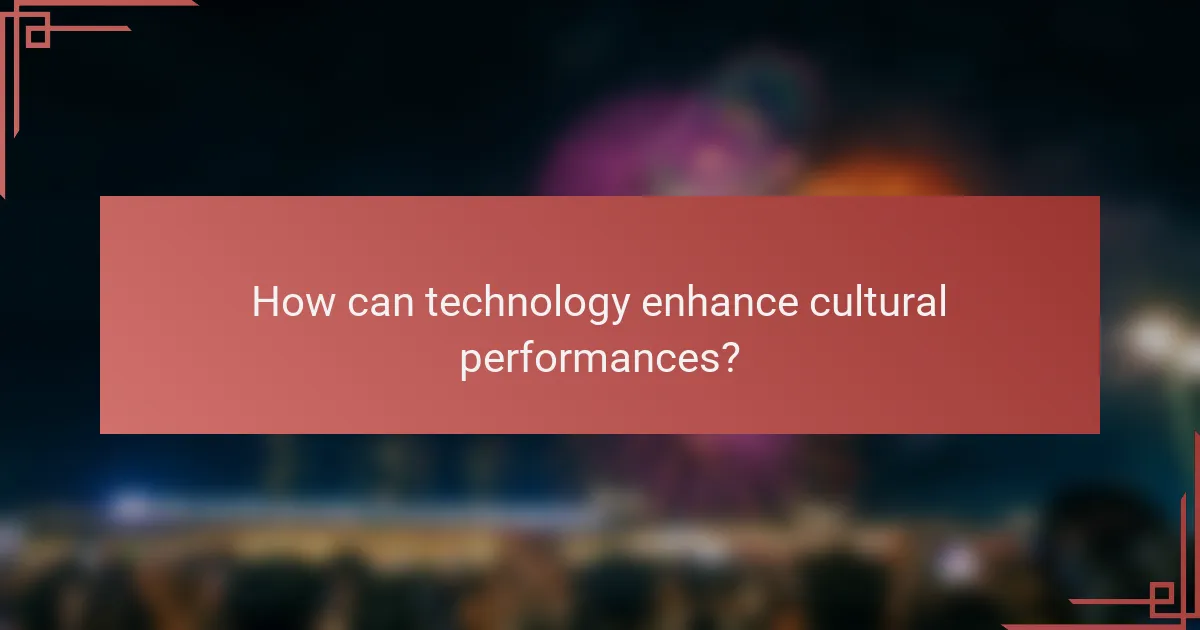
How can technology enhance cultural performances?
Technology can significantly enhance cultural performances by making them more accessible, immersive, and engaging for diverse audiences. By integrating tools like virtual reality, live streaming, and social media, cultural organizations can reach wider audiences and foster community involvement.
Virtual reality experiences
Virtual reality (VR) experiences allow audiences to immerse themselves in cultural performances from anywhere in the world. By using VR headsets, viewers can feel as though they are part of the event, enhancing their emotional connection to the performance.
To implement VR, organizations should consider creating 360-degree videos of performances or interactive experiences that allow users to explore cultural settings. This technology can attract younger audiences and those unable to attend in person due to geographical or physical constraints.
Live streaming events
Live streaming events enable cultural performances to reach global audiences in real-time. This approach not only increases visibility but also allows for interactive elements, such as live chats and Q&A sessions, enhancing viewer engagement.
When planning a live stream, ensure high-quality video and audio to replicate the in-person experience as closely as possible. Promote the event across various platforms to maximize attendance and consider offering recorded versions for later viewing to cater to different time zones.
Social media engagement
Social media platforms serve as powerful tools for promoting cultural performances and engaging with audiences. By sharing behind-the-scenes content, interviews, and highlights, organizations can build excitement and foster a sense of community.
To effectively engage on social media, create a content calendar that includes regular updates and interactive posts, such as polls or contests. Utilize hashtags related to the performance to increase visibility and encourage audience participation, making them feel like part of the cultural experience.
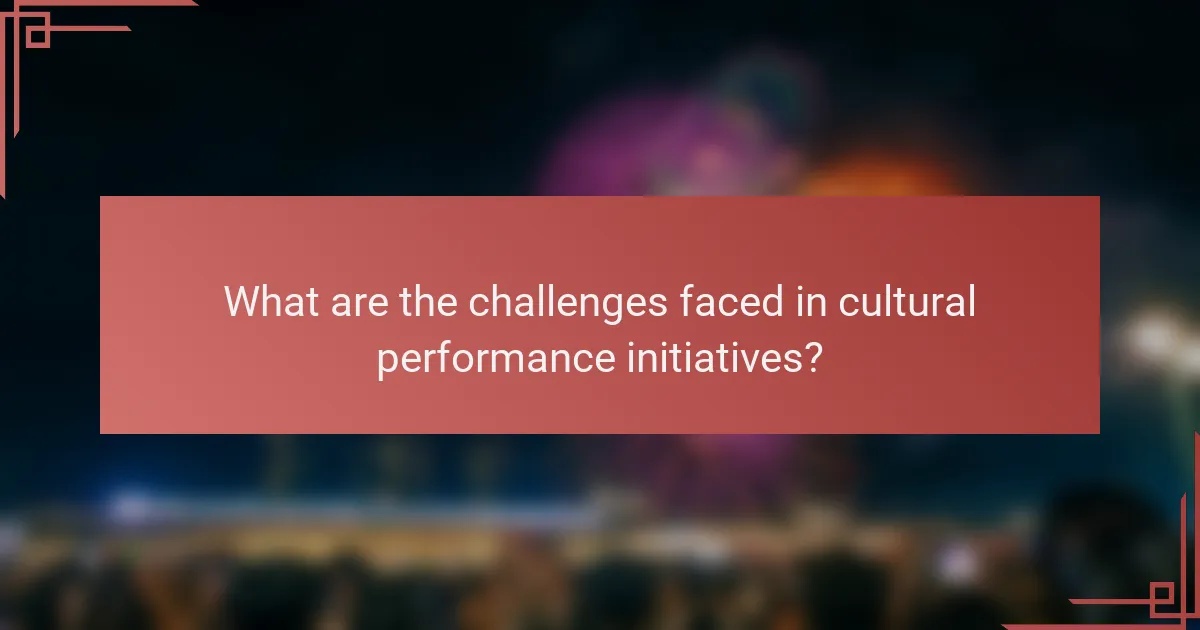
What are the challenges faced in cultural performance initiatives?
Cultural performance initiatives often encounter several challenges that can hinder their success, including funding limitations, community engagement issues, and logistical hurdles. Addressing these challenges is crucial for preserving heritage, fostering community involvement, and attracting visitors.
Funding limitations
Funding limitations are a significant barrier for cultural performance initiatives, impacting their ability to sustain operations and deliver quality experiences. Many projects rely on grants, sponsorships, or ticket sales, which can fluctuate based on economic conditions and public interest.
To navigate funding challenges, organizations should diversify their revenue streams. This can include seeking partnerships with local businesses, applying for government grants, or launching crowdfunding campaigns. Establishing a clear budget and financial plan is essential for long-term viability.
Additionally, organizations should consider hosting fundraising events or workshops that not only generate income but also engage the community. By creating a strong local presence, initiatives can enhance their appeal to potential donors and sponsors.

